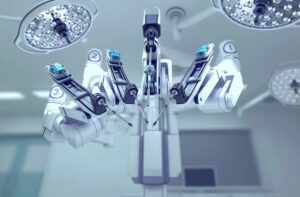By Iris Farrou
31 Jul, 2023
Da Vinci Robotic Surgery, Health Conditions and Pregnancy, Hysterectomy, Menopause, Peri-Menopause, Peri-Menopause, Procedures, Queer Health, Reproductive health, Robot Hysterectomy, WNY Ob-Gyn News, Women's Health
3D imaging, abnormal vaginal bleeding, Cancer Treatment, cervical, cervix, endometriosis, faster recovery, fibroids, Laparoscopic Surgery, minimally invasive surgery, Ovarian, ovaries, pelvic pain, Precancer, Robot Assisted Hysterectomy, Robot Hysterectomy, uterine, uterine prolapse, uterus
 What is it?
What is it?
You may have heard of a traditional hysterectomy, which refers to the surgical procedure to remove the uterus (hysteros) from the body. In this case, the procedure is done with a large incision and requires longer recovery time. Nowadays, doctors can use robotic technology to their advantage–and to the advantage of the patients–to perform certain procedures, hysterectomy being one of them. In robotic hysterectomy, your doctor uses the technology to make small incisions of 1-2cm and fully controls the robotic arms with a controller while looking at a 3D magnified image of the area of surgery on their screen.
How does it work?
Robotic hysterectomy is a type of laparoscopic surgery: it is less invasive than traditional surgery, and patients experience much less pain, faster recovery, and less blood loss than open abdominal hysterectomy. Your doctor makes small incisions on your abdomen, and then inserts a laparoscope and other surgical instruments through the incisions. The laparoscope is a very thin tube with light and a camera at the end, thus projecting the surgery on a high-definition and magnified screen; this allows your surgeon to be aware of a lot more details during the surgery, as well as possible problems, than the human eye itself since the image is magnified up to 15 times.
The instruments used during robotic hysterectomy, particularly the technology of the daVinci surgical system, mimic the movement of human hands but with a lot more dexterity, precision, and flexibility. Your surgeon has full control over the instruments at all times, and they would be in the operating room just a few feet away from you. As opposed to traditional surgery where the surgeon would be standing over you for long periods of time, robotic hysterectomy allows your surgeon to utilize the constant steadiness of the robot arms to operate from angles and positions that would be typically hard to reach. Keep in mind that the robotic arms are more precise than natural hand movements, and they will not get tired during the surgery.
Who needs it?
Hysterectomies may be suggested to treat conditions like cancer or precancer of the uterus, cervix, and ovaries, uterine prolapse, endometriosis, uterine fibroids, pelvic pain, and abnormal vaginal bleeding.
Robotic hysterectomy is one of the methods surgeons can use to remove the uterus from the body, and though less invasive and more precise, surgeons decide on a case by case basis whether robotic hysterectomy is an appropriate option for their patients. Robot assisted procedures can be especially helpful if you have a complex surgical case, such as scar tissue that binds surrounding organs together and would need more precision during surgery.
What happens after it?
Like with any surgery, there will be a recovery period. Patients who have had robotic hysterectomies report that they heal faster and experience less pain; we need to remember that every body is different, and that people recover at different rates. After a robotic hysterectomy, you may be expected to stay the night at the hospital, and you may experience vaginal bleeding for a few days or weeks after your surgery. Full recovery can take 3-4 weeks, and vaginal intercourse should be avoided for at least 6 weeks after the surgery. If you are concerned about any symptoms or adverse reactions, reach out to your doctor and immediately seek professional assistance.
https://my.clevelandclinic.org/health/treatments/21057-robotic-assisted-hysterectomy
https://www.mayoclinic.org/tests-procedures/robotic-hysterectomy/about/pac-20384544
More
By Iris Farrou
05 Dec, 2021
Women's Health
Best gyns in Buffalo, Best OB practices in Buffalo, Best OBGYN Groups in Buffalo, Buffalo OBGYN, Chouchani MD, endometriosis, WNY OB-GYN, WNY Ob-gyn doctors, WNY OBGYN, women's health

If you have been diagnosed with endometriosis or may suspect you are included in the percentage of the female population that has it, you may be concerned about your fertility levels and/or conceiving and carrying to term. Endometriosis is very common and affects between 6% and 10% of the general female population. About 30%-50% of women with it are infertile, and about 25%-50% of infertile women have endometriosis.
Here are some options to consider if you are diagnosed with endometriosis and are interested in becoming pregnant:
Expert Assistance
It is possible that some surgical operations associated with the diagnosis and treatment of endometriosis may affect your ability to become pregnant, so if you haven’t yet undergone any surgical procedures, it would be a good idea to discuss the risks with your doctor. You may also want to consider working with a fertility specialist who will help you find out the contributing factors to your infertility and determine the severity of your disorder.
Improving your Chances
There is no current evidence that suggests medication can assist you in getting pregnant if you live with endometriosis. However, your doctor may instruct you to take progestins so you can increase the level of pregnancy hormones in your body. Another suggestion is to follow a healthy lifestyle so you can decrease the chances of inflammation in your body and help your baby thrive throughout a healthy pregnancy:
- Maintain weight that is healthy for your body type.
- Engage in moderate exercise in your daily life.
- Consume nutrient-dense foods.
Treatments
- Fertility medications are fairly common for women with endometriosis. These can range from progestin injections to fertility medications like Clophemene to help you produce 2-3 mature eggs.
- You may also undergo regular ultrasounds to determine the maturity of your eggs. At the appropriate time, your doctor can insert collected sperm to assist in conceiving.
- In vitro fertilization is also an option couples go for, whereby the egg is fertilized outside the body and then inserted into the uterus.
- If you have mild endometriosis, or your endometriosis has not affected your fallopian tubes, you may consider intrauterine insemination.
- A more costly option, and usually not covered by insurance, is to freeze your eggs. Endometriosis can affect your ovarian reserve, so this option helps if you want to try and become pregnant at a later time.
The good news is that many women living with endometriosis have managed to get pregnant using IVF, especially in cases of moderate or mild endometriosis. Though the chances are about 50% less than those of couples who use IVF due to other infertility reasons, many women with endometriosis are able to conceive and deliver a healthy baby. It is recommended that you start discussing your fertility options with your doctor even before you are thinking of getting pregnant.
Learn more about IVF: https://wny-obgyn.com/2022/03/ivf-step-by-step/
More
 What is it?
What is it?
